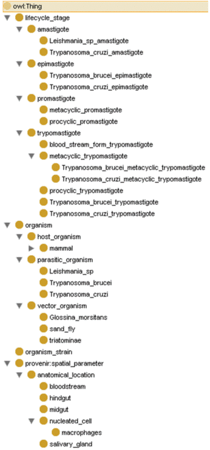Ontology for Parasite Life Cycle
This ontology is mainly descriptive of trypanosomatid parasites.
Contents
Introduction
The life cycle of Trypanosoma cruzi involves both mammalian and invertebrate hosts. Metacyclic trypomastigotes are deposited on the mammalian skin in the faeces of the triatomine bug vector. They have the capacity to penetrate skin through wounds, such as the bite from the bug, and across the mucosal membranes surrounding the eyes and mouth.
Inside the mammalian host, the trypomastigotes penetrate either phagocytic or non-phagocytic cells, in a manner distinct from phagocytosis. Parasites subvert the host cell Ca2+ -regulated lysosomal exocytic pathway, literally ‘hijacking’ lysosomes to enable them to invade effectively (Sibley and Andrews, 2000; Tan and Andrews, 2002). Within the host cell, trypomastigotes are initially held within a membrane bound vacuole. They subsequently enter the host cell cytoplasm directly, transforming into amastigotes (the intracellular replicative forms) (Tan and Andrews, 2002). Around five days post invasion, the amastigotes transform back into C- shaped trypomastigotes, and the host cell ruptures, releasing the parasites into the bloodstream. These bloodstream trypomastigotes can then either infect further cells, or can be taken up by a reduviid bug. Within the insect vector, epimastigotes develop in the alimentary tract, taking 10 – 15 days to replicate and transform into infective stages in the rectum (Kollien and Schaub, 2000). T. cruzi can also be transmitted via contaminated blood and infected organs used in transplant operations, or congenitally from mother to child.
T. brucei is also transmitted by an insect vector, in this case the tsetse fly, one of the Glossina sp. Blood stream trypomastigotes are ingested by the tsetse from an infected patient during the insect blood meal. In the midgut of the tsetse, the trypanosomes develop into procyclic forms that divide by binary fission. Some of these then migrate to the salivary glands where they differentiate into infectious metacyclic trypomastigotes. These are transmitted into new hosts during further blood feeds (Barrett et al, 2003).
Leishmania species are also transmitted by insect vectors, in this case metacyclic promastigotes are introduced into the skin by the bite of various species of sand fly. These are taken up by macrophages and transform into intracellular amastigotes (reviewed by Handman and Bullen, 2002), remaining in this form for the duration of the life cycle in the mammalian host. Development within the sand fly vector varies from species to species, but is thought to involve 2 distinct growth phases (Gossage et al, 2003).
Ontology description
All the entities in the ontology are linked to each other by explicitly modeled named relationship that will enable software applications to accurately interpret data annotated with this ontology. For example, “Trypanosoma_cruzi→has_vector_organism(named relationship)→triatominae”. The parasite life cycle ontology is modeled in the World Wide Web consortium (W3C) Web Ontology Language (OWL) standard and currently has 41 classes and 5 properties with a description logic (DL) expressivity of ALU. The ontology, along with its Wiki-based resource page will be released for listing and public use at NCBO in the latter half of this month (February, 2009). We expect this ontology to replace the current prototype ontology modeling parasite life cycle for which development effort has apparently been discontinued since 2002.
List of ontology classes
table width=60%
tr valign=top
td
- A
ul liAmastigote/li liAnatomical Location /li /ul
- B
ul
liBlood stream form/li
liBloodstream/li
/ul
- C
ul
liChagas disease/li
/ul
- D
ul
liDog/li
/ul
- E
ul
liEpimastigote/li
/ul
- H
ul
liHindgut/li
liHost organism/li
liHuman/li
/ul
- K
ul
liKinetoplastid/li
/ul
- L
ul
liLeishmania/li
liLeishmaniasis/li
liLifecycle stage/li
liLutzomyia/li
/ul
- M
ul
liMacrophage/li
liMetacyclic/li
liMice/li
liMidgut/li
/ul
- N
ul
liNew World/li
liNucleated Cell/li
/ul
- O
ul
liOld World/li
liOntology/li
liOrganism/li
/ul
- P
ul
liParasitic organism/li
liPhlebotomus/li
liProcyclic/li
liPromastigote/li
/ul
- S
ul
liSalivary Gland/li
liSand fly/li
liSleeping sickness/li
liStrains/li
/ul
- T
ul
liTriatomine/li
liTrypanosoma brucei/li
liTrypanosoma cruzi/li
liTrypomastigote/li
liTsetse fly/li
/ul
- V
ul
liVector organism/li
/ul
/td
/tr
/table
Collaborating Institutions
br/
We invite new members to collaborate with us in extending this ontology.
Feedback/Comments
Please add feedback/comments in Discussion Section on the top of this wiki page.
